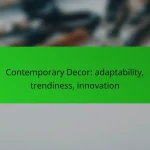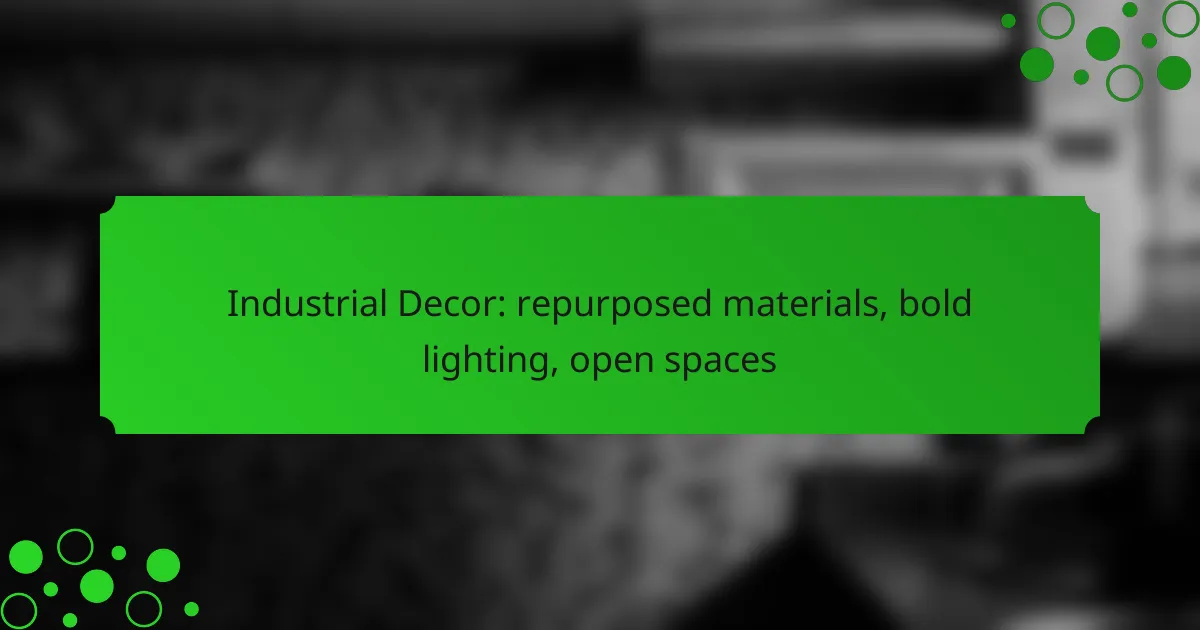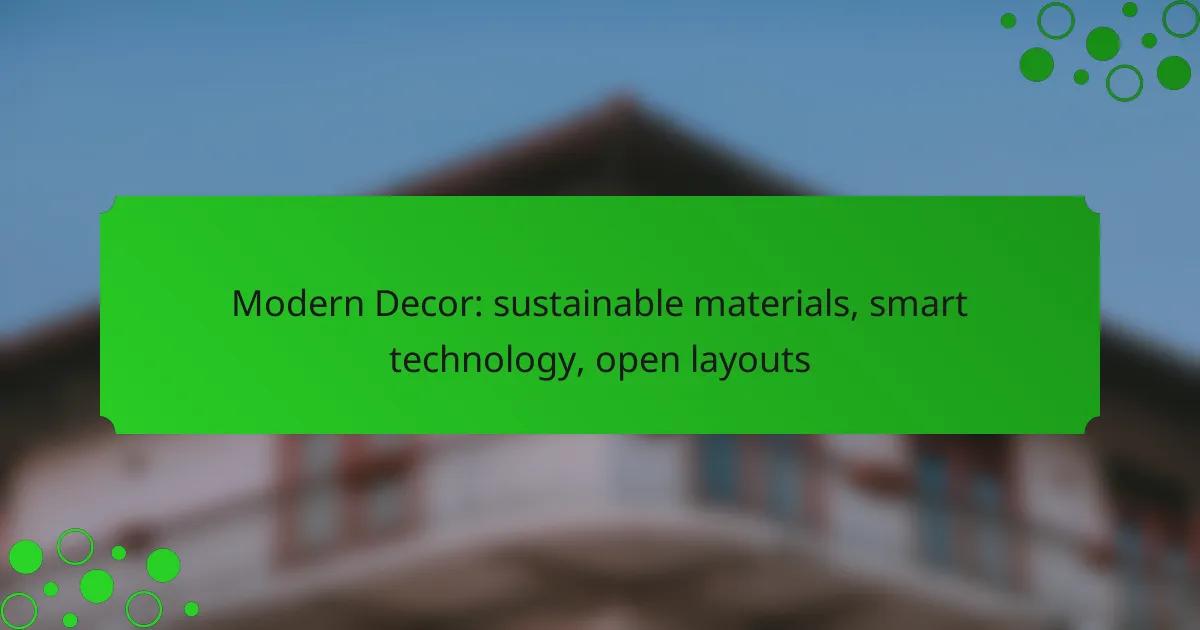Industrial decor embraces the charm of repurposed materials, infusing spaces with character and sustainability. By combining bold lighting and open layouts, this design style highlights the raw aesthetic while ensuring functionality and spaciousness. The result is a unique environment that balances form and function, creating an inviting atmosphere.

How to incorporate repurposed materials in industrial decor?
Incorporating repurposed materials in industrial decor adds character and sustainability to your space. Focus on sourcing items that reflect the raw, unfinished aesthetic typical of industrial design while ensuring they are functional and safe.
Using reclaimed wood for furniture
Reclaimed wood is a popular choice for industrial furniture due to its durability and unique appearance. Look for pieces that have a weathered finish, which can add warmth and texture to your decor.
When selecting reclaimed wood, consider its source and treatment. Ensure it is free from harmful chemicals and pests. Common options include barn wood, pallets, and old beams, which can be transformed into tables, chairs, or shelving units.
Upcycling metal for wall art
Upcycling metal can create striking wall art that enhances the industrial vibe of your space. Items like old gears, pipes, or scrap metal can be creatively arranged to form sculptures or wall hangings.
Consider the weight and sharp edges of the metal pieces to ensure safety during installation. Use strong adhesives or brackets to secure them to the wall, and think about incorporating lighting to highlight the textures and shapes.
Repurposing pallets for shelving
Pallets are versatile and readily available materials that can be easily transformed into functional shelving units. They can be used as-is for a rustic look or sanded and stained for a more polished finish.
When repurposing pallets, check for any damage or chemical treatments. Ensure they are sturdy enough to hold the intended weight. A simple design could involve stacking pallets vertically or horizontally to create open shelving for books or decorative items.

What are the best bold lighting options for industrial spaces?
Bold lighting options for industrial spaces enhance the raw aesthetic while providing functional illumination. Key choices include industrial pendant lights, LED strip lighting, and vintage Edison bulbs, each contributing uniquely to the overall atmosphere.
Industrial pendant lights
Industrial pendant lights are a staple in modern industrial decor, known for their robust designs and versatility. They often feature materials like metal or glass and come in various shapes, making them suitable for both task and ambient lighting.
When selecting pendant lights, consider the height of your ceilings and the size of the space. Larger fixtures work well in open areas, while smaller pendants can create intimate settings. Aim for a mix of heights to add visual interest.
LED strip lighting for accent features
LED strip lighting is an effective way to highlight architectural features or create mood lighting in industrial spaces. These flexible strips can be installed under shelves, along ceilings, or around windows to provide a modern touch.
When using LED strips, choose colors that complement your decor. Warm white tones can create a cozy atmosphere, while cooler colors can enhance a sleek, contemporary look. Ensure the strips are rated for the intended environment, especially in areas with moisture.
Vintage Edison bulbs for ambiance
Vintage Edison bulbs are popular for adding warmth and character to industrial spaces. Their exposed filaments create a nostalgic feel, making them perfect for fixtures where the bulb is visible.
To maximize their effect, pair Edison bulbs with simple fixtures that allow their design to shine. Use them in clusters or as standalone pieces to create focal points. Keep in mind that these bulbs typically have lower lumens, so they are best used in conjunction with other lighting sources for adequate illumination.

How to design open spaces with industrial decor?
Designing open spaces with industrial decor involves creating a layout that emphasizes spaciousness and functionality while incorporating raw materials and bold lighting. Key elements include minimal partitions, large windows, and multifunctional furniture that enhance the overall aesthetic and usability of the space.
Creating a layout with minimal partitions
To achieve an open feel in industrial decor, focus on layouts that minimize walls and barriers. Use furniture placement to define areas instead of traditional partitions, allowing for fluid movement and interaction. For example, a large dining table can serve as a central gathering point without enclosing the space.
Consider using sliding doors or movable screens for flexibility. This allows you to adapt the space for different activities while maintaining an open atmosphere. Avoid cluttering the area with unnecessary furniture that can disrupt the flow.
Utilizing large windows for natural light
Large windows are essential in industrial decor, as they invite natural light and create a sense of openness. Opt for floor-to-ceiling windows or expansive glass panels to maximize daylight and enhance the connection between indoor and outdoor spaces. This not only brightens the area but also highlights the industrial materials used in the design.
When designing, ensure that window placements are strategic to avoid glare while still providing ample light. Consider using sheer curtains or blinds that can be adjusted to control brightness without obstructing views.
Incorporating multifunctional furniture
Multifunctional furniture is key in open spaces, allowing for versatility and efficient use of space. Look for items like coffee tables that can convert into dining tables or sofas that include storage. This helps maintain a clean, uncluttered look while providing practical solutions for everyday needs.
When selecting furniture, prioritize pieces that reflect the industrial style, such as those made from reclaimed wood or metal. This not only aligns with the decor theme but also contributes to sustainability by repurposing materials.

What are the key elements of industrial decor?
Industrial decor is characterized by its raw, unfinished look, often incorporating elements like repurposed materials, bold lighting, and open spaces. Key components include exposed structural elements, metal fixtures, and a neutral color palette accented with vibrant hues.
Exposed brick and concrete finishes
Exposed brick and concrete finishes are foundational to industrial decor, providing a rugged and authentic aesthetic. These materials often highlight the building’s history and structure, making them ideal for both residential and commercial spaces.
When incorporating these finishes, consider leaving walls bare or using a clear sealant to enhance their natural texture. This approach not only adds character but also minimizes the need for additional wall treatments.
Metal fixtures and fittings
Metal fixtures and fittings, such as light fixtures, railings, and furniture, are essential in industrial design. They add a sleek, modern touch while maintaining the raw feel of the space. Common materials include steel, iron, and brass, which can be left in their natural state or painted for a different effect.
To achieve a cohesive look, choose fixtures that complement the overall design. For example, pairing matte black metal with warm wood tones can create an inviting atmosphere while still embracing industrial elements.
Neutral color palettes with bold accents
A neutral color palette serves as the backdrop for industrial decor, allowing bold accents to stand out. Shades like gray, beige, and white create a calm environment, while vibrant colors can be introduced through furniture, artwork, or decorative items.
When selecting accent colors, consider using deep reds, blues, or yellows to create visual interest. This approach not only enhances the industrial theme but also allows for personal expression within the space.

How to choose the right industrial decor for your home?
Selecting the right industrial decor for your home involves understanding your space, personal style, and budget. Focus on elements like repurposed materials, bold lighting, and open spaces to create a cohesive industrial aesthetic.
Assessing space and layout
Begin by evaluating the dimensions and layout of your home. Industrial decor thrives in open spaces, so consider how furniture placement can enhance flow and functionality. High ceilings and large windows are ideal for showcasing bold lighting fixtures.
Measure your space to determine the scale of furniture and decor items. Oversized pieces can overwhelm smaller areas, while minimalistic designs may get lost in expansive rooms. Aim for a balance that complements your layout.
Identifying personal style preferences
Your personal style should guide your industrial decor choices. Consider whether you prefer a raw, unfinished look with exposed brick and metal, or a more polished approach with sleek lines and refined finishes. Collect inspiration from online platforms or design magazines.
Think about color palettes that resonate with you. Industrial decor often features neutral tones, but adding bold accents can personalize the space. Create a mood board to visualize how different elements will work together.
Considering budget and sourcing options
Establishing a budget is crucial when selecting industrial decor. Prices can vary widely based on materials and sourcing methods. Repurposed items can be cost-effective, while custom pieces may require a larger investment.
Explore local thrift stores, online marketplaces, and auctions for unique finds. Consider DIY projects to transform inexpensive materials into statement pieces. Always compare prices and quality to ensure you get the best value for your investment.

What are the trends in industrial decor for 2024?
In 2024, industrial decor trends emphasize repurposed materials, bold lighting, and open spaces. These elements create a raw yet sophisticated aesthetic, appealing to those who appreciate a blend of functionality and style.
Repurposed Materials
Repurposed materials are at the forefront of industrial decor, promoting sustainability while adding character to spaces. Items like reclaimed wood, salvaged metal, and vintage fixtures are commonly used to create unique furniture and decor pieces.
When incorporating repurposed materials, consider the history and texture they bring. For instance, using reclaimed wood for shelving not only adds warmth but also tells a story. Look for local suppliers or online marketplaces specializing in salvaged goods to find authentic materials.
Bold Lighting
Bold lighting is essential in industrial decor, serving both functional and aesthetic purposes. Fixtures made from metals, such as steel or brass, often feature exposed bulbs that enhance the raw look typical of industrial spaces.
To achieve the best effect, mix different types of lighting, such as pendant lights over dining areas and floor lamps in living spaces. Aim for a combination of ambient and task lighting to create a well-lit, inviting environment. Consider using dimmable options to adjust the mood as needed.
Open Spaces
Open spaces are a hallmark of industrial decor, promoting a sense of freedom and flow within a home or workspace. This trend encourages the removal of unnecessary walls and the use of large, airy layouts to enhance natural light.
When designing open spaces, focus on furniture arrangement and zoning to define areas without physical barriers. Use rugs or lighting to delineate different functions, such as a cozy reading nook or a dining area. This approach not only maximizes space but also fosters a communal atmosphere.










